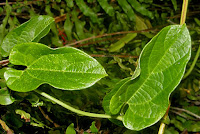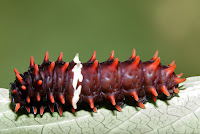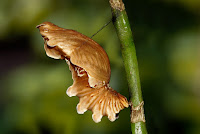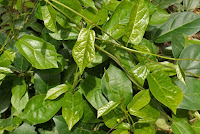<> Pachliopta aristolochiae (Fabricius, 1775) <>
the Common Rose ผีเสื้อหางตุ้มจุดชมพู
Click on any photo to see all photos full size in Lightbox
Additions and corrections to the information provided on this page is always welcome. Please use the Contact form.

Photo taken at Chiang Dao Nature Sanctuary, Chiang Mai, Thailand 540m a.s.l.

Pachliopta aristolochiae is fairly common and widespread throughout the whole region. The species is only mildly dimorphic and both sexes are visually similar but the female is slightly larger and the hindwing spots tend to be redder. The apex of the forewing on the female is more rounded and the hindwing tails more pointed. It usually flies high and slow, and is active from early in the morning and throughout most of the day. The red colouring on the body and wings serves as a warning to potential vertebrate predators, such as birds and lizards, that the butterfly is distasteful or toxic.
This species is multivoltine with seven or eight generations per year. The adult female lays her eggs singly on the young leaves or shoots of the host plant. She lays around 100 eggs in total. The species is solely dependent on plants in the Aristolochiaceae family as its larval hosts. The larvae ingest toxins from these plants and these are passed on to the adults to give them the protection from predators as mentioned above.
Synonyms: Atrophaneura aristolochiae, Papilio aristolochiae, Papilio ascanius, Papilio diphilus, Tros aristolochiae
Taxonomy: Animalia - Arthropoda - Insecta - Lepidoptera - Papilionidae - Papilioninae - Pachliopta - aristolochiae
Regional subspecies: P.aristolochiae aristolochiae (India), P.aristolochiae asteris (S.Thailand, Malaysia, Singapore), P.aristolochiae goniopeltis (Myanmar, Thailand, Laos, Cambodia, Vietnam, S.China), P.aristolochiae interpositus (Taiwan, Philippines). There are also a number of different subspecies listed amongst the islands of Indonesia.
Regional Distribution: India, Nepal, Bhutan, Bangladesh, Myanmar, Thailand, Laos, Vietnam, Cambodia, China, Taiwan, Malaysia, Singapore, Brunei, Indonesia, Philippines
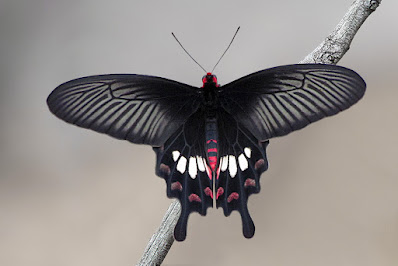 |
| Lamnamkok National Park, Chiang Rai, Thailand 450m a.s.l. |
Habitat: Pachliopta aristolochiae is found in a wide variety of habitats, including open forest, forest edges, grassland, and urban parks & gardens. Often seen in the vicinity of streams at low to moderate elevations up to 2400m a.s.l.
Flight time: all year depending on location Wingspan: 80-100mm
Life History: egg 3-7 days instar 1 1-3 days instar 2 3-4 days instar 3 3-4 days instar 4 4-5 days instar 5 4-7 days pupa 12-18 days Total egg to adult 30-48 days. All times are approximate and various studies have found significant differences in life cycle periods. It was also noted that sometimes there are only four larval instars and sometimes as many as six.
Larval Hosts: Aristolochia acuminata, Aristolochia bracteolata, Aristolochia cucurbitifolia, Aristolochia fordiana, Aristolochia foveolata, Aristolochia griffithi, Aristolochia heterophylla, Aristolochia indica, Aristolochia kaempferi, Aristolochia klossii, Aristolochia littoralis, Aristolochia ringens, Aristolochia zollingeriana, Thottea parviflora, Thottea philippinensis, Thottea piperiformis, Thottea siliquosa, Thottea tomentosa (Aristolochiaceae), Dioscorea wallichii (Dioscoreaceae).
Actual host plant used depends upon location and availabilty of plant species.
Adult Food Sources: Nectar - Buddleja davidii (Scrophulariaceae), Duranta erecta, Lantana camara, Stachytarpheta indica (Verbenaceae), Ageratina adenophora, Chromolaena odorata, Cosmos sp., Crassocephalum crepidioides, Dahlia imperialis, Tagetes erecta, Tithonia diversifolia, Tridax procumbens, Zinnia sp. (Asteraceae), Jatropha sp. (Euphorbiaceae), Clerodendrum infortunatum, Platostoma axillaris, Premna serratifolia, Vitex negundo (Lamiaceae), Alstonia scholaris, Catharanthus roseus, Wrightia tinctoria (Apocynaceae), Caesalpinia pulcherrima, Libidibia coriaria (Fabaceae), Adina cordifolia, Ixora coccinea (Rubiaceae), Ziziphus mauritiana, Ziziphus oenoplia (Rhamnaceae), Ehretia aspera, Trichodesma indicum (Boraginaceae), Senna siamea (Amaranthaceae), Cestrum aurantiacum, Solanum mauritianum (Solanaceae), Abutilon hirtum, Hibiscus rosa-sinensis, Sida acuta, Sida cordifolia, Waltheria indica (Malvaceae), Hypericum mysurense (Hypericaceae), Rhododendron arboreum (Ericaceae), Acacia mearnsii (Mimosaceae), Antigonon leptopus (Polygonaceae), Bougainvillea glabra, Bougainvillea spectabilis (Nyctaginaceae), Muntingia calabura (Muntingiaceae). Other - mud puddling.
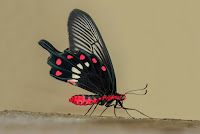 |
| Phou Si Mountain, Luang Prabang, Laos |
 |
| Chromolaena odorata, a nectar source |
 |
| Duranta erecta, another nectar source |
Links to other pages in this series for species in the same subfamily

